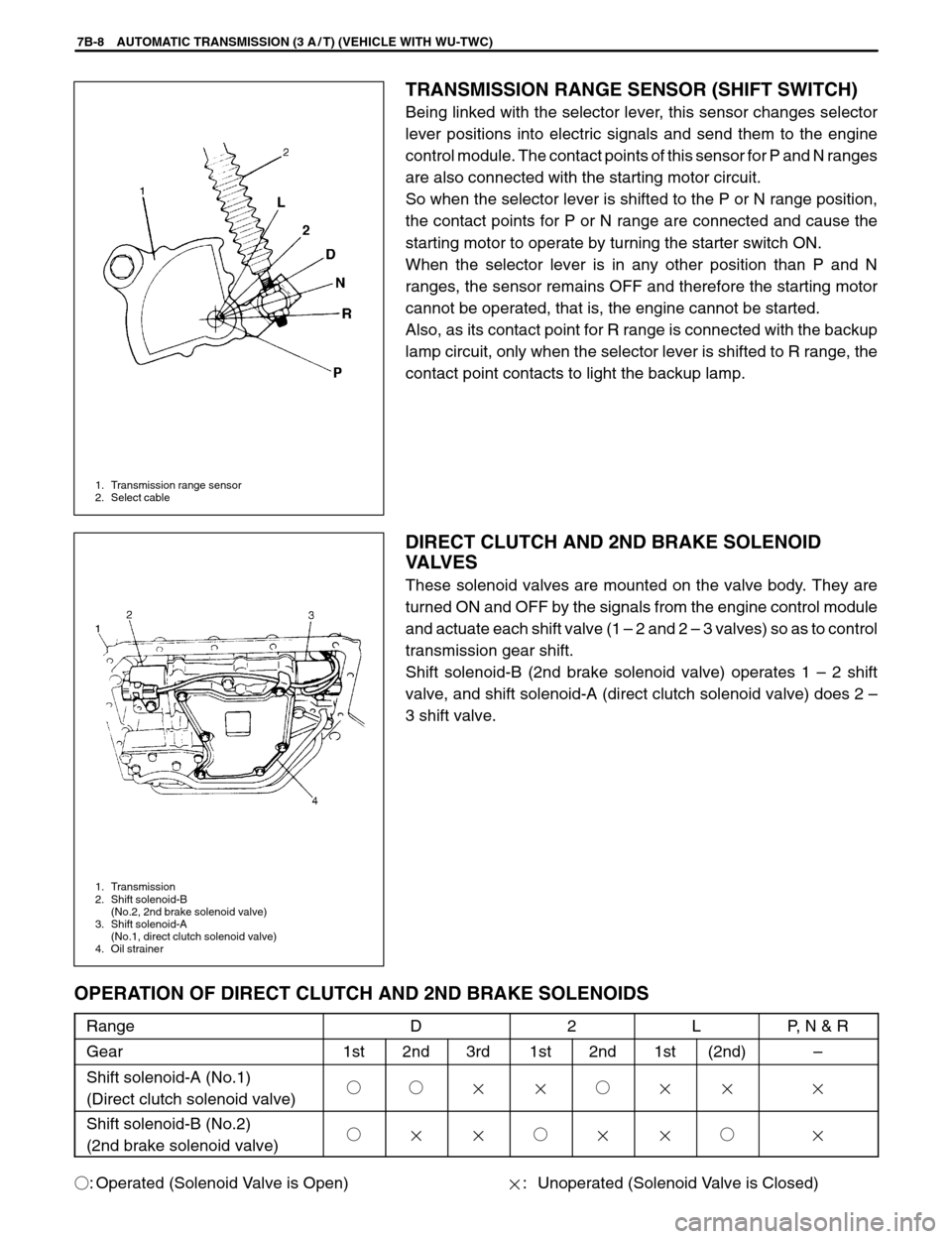Page 252 of 557

6-1-96 ENGINE GENERAL INFORMATION AND DIAGNOSIS (SFI FOR G13)
Main
fuse
M/T vehicle
A/T vehicle
Ignition
switch
(starter
switch)
Starter
Starter Transmission
range sensor (switch) Main
fuse
Ignition
switch
(starter
switch)
DTC P1500 ENGINE STARTER SIGNAL CIRCUIT MALFUNCTION
CIRCUIT DESCRIPTION
DTC DETECTING CONDITIONPOSSIBLE CAUSE
�Low voltage at terminal C03-17 when cranking
engine or
�High voltage at terminal C03-17 after starting engine.
�2 driving cycle detection logic, continuous monitoring.�“B/Y” circuit open
�ECM (PCM) malfunction
DTC CONFIRMATION PROCEDURE
1) Turn ignition switch OFF.
2) Clear DTC with ignition switch ON, crank engine and run it at idle for 3 min.
3) Check pending DTC in “ON BOARD TEST” or “PENDING DTC” mode and DTC in “DTC” mode.
INSPECTION
STEPACTIONYESNO
1Was “ENGINE DIAG. FLOW TABLE” performed?Go to Step 2.Go to “ENGINE DIAG.
FLOW TABLE”.
2Check for voltage at terminal C03-17 of ECM
(PCM) connector connected, under following
condition.
While engine cranking : 6 – 10 V
After starting engine : 0 V
Is voltage as specified?Poor C03-17
connection or
intermittent trouble.
Check for intermittent
referring to “Intermittent
and Poor Connection”
in Section 0A.
If wire and connections
are OK, substitute a
known-good ECM
(PCM) and recheck.“B/Y” circuit open.
Page 288 of 557

6A-24 ENGINE MECHANICAL (G10, 1-CAM 6-VALVES ENGINE)
UNIT REPAIR OVERHAUL
ENGINE ASSEMBLY
REMOVAL
1) Relieve fuel pressure according to procedure described in
“FUEL PRESSURE RELIEF PROCEDURE” of Section 6.
2) Remove engine hood after disconnecting front window washer
hose.
3) Disconnect battery cables at battery and remove battery and
its tray.
4) Drain cooling system.
5) Remove air cleaner assembly.
6) Remove radiator with cooling fan. Refer to Section 6B for re-
moval.
7) Disconnect the following electric wire harness.
�High-tension cord from ignition coil
�Distributor
�EGR valve
�ECT sensor
�ISC actuator
�Ground wire harness from intake manifold
�TP sensor
�Fuel injector
�Oil pressure gauge
�A / C compressor pressure switch (if equipped)
�Heated oxygen sensor
�Generator
�Starter
�Back-up light switch (For M / T model)
�Battery negative cable from transmission
�Shift switch of A / T (For A / T model)
�Direct clutch and 2nd brake solenoids of A / T (For A / T model)
�Vehicle speed sensor on A / T (For A / T model)
And release above wire harness from clamps.
8) Disconnect the following vacuum hose.
�Brake booster hose from intake manifold.
�Canister purge hose from EVAP canister purge valve.
�Pressure sensor hose from intake manifold.
9) Disconnect fuel return hose and fuel feed hose from fuel feed
and return pipes.
10) Disconnect heater inlet and outlet hoses.
Page 360 of 557
ENGINE MECHANICAL (G13B, 1-CAM 16-VALVES ENGINE) 6A1-65
12) Disconnect the following electric wires:
�Ignition coil assembly
�Ground wires from intake manifold
�Engine oil pressure switch
�EVAP canister purge valve (if equipped)
�Engine coolant temp. sensor
�Fuel injectors
�Power steering pressure switch (if equipped)
�Oxygen sensor-1
�Back-up light switch (M / T)
�Transmission range switch (A / T)
�A/T vehicle speed sensor (A / T)
�Solenoid coupler (A / T)
�Generator
�Starter
�Battery negative cable from transmission
�TP sensor
�IAC valve
�CMP sensor
�MAP sensor
and then release wire harnesses from clamps.
13) Disconnect the following hoses:
�Canister purge hose (2) from EVAP canister purge valve
�Brake booster hose (1) from intake manifold
�Radiator outlet hose from inlet pipe
�Heater inlet and outlet hose from heater unit
14) Disconnect fuel feed (2) and return hoses (3) from fuel delivery
pipe (1).
Page 398 of 557

ENGINE AND EMISSION CONTROL SYSTEM (TBI FOR G10) 6E1-7
CON-
NECTOR
C02TERMI-
NAL
1
2
3
4
5
6
7
8
9
10
11
12
13
14
15
16
17
18
19
20
21
22
23
24
25
26ECM ground
Power source (from main relay)
Blank
Blank
Blank
Blank
EVAP canister purge valve
Shift solenoid-B (A / T)
Shift solenoid-A (A / T)
Igniter
Idle speed control actuator
Fuel injector
Injector ground
Power source (from battery)
Power source (from main relay)
Idle speed control actuator relay
Malfunction indicator lamp
Immobilizer indicator lamp
Heater of HO2S-2
Radiator fan relay
Fuel pump relay
Main relay
Blank
Idle speed control actuator
EFE heater relay
Injector groundC031
2
3
4
5
6
7
8
9
10
11
12
13
14
15
16
17
18
19
20
21
22Data link connector
Vehicle speed sensor (+) (A / T)
Vehicle speed sensor (M / T)
Transmission range sensor (switch)“2”
Transmission range sensor (switch)“N”
Transmission range sensor (switch)“P”
Blank
Blank
Heated oxygen sensor-2
Blank
Fuel level sensor (gauge)
Blank
Data link connector
Vehicle speed sensor (–) (A / T)
Transmission range sensor (switch)“L”
Transmission range sensor (switch)“D”
Transmission range sensor (switch)“R”
A / C ON (output) signal for A / C control module
(if equipped)
Electric load signal
A / C (input) signal from A / C control module
(if equipped)
Ignition switch
Blank
Blank CIRCUITCON-
NECTORTERMI-
NALCIRCUIT
1
2
3
4
5
6
7
8
9
10
11
12
13
14
15
16Power source for sensors
Camshaft position sensor (+)
Crankshaft position sensor (+)
Closed throttle position switch
Manifold absolute pressure sensor
Throttle position sensor
Engine coolant temp. sensor
Heater of HO2S-1
Sensor ground
Camshaft position sensor (–)
Crankshaft position sensor (–)
EFE heater (monitor)
Heated oxygen sensor-1
Intake air temp sensor
Power steering pressure switch (if equipped)
Engine start signal circuit
C01
1. CMP sensor (in Distributor)
2. CKP sensor
3. TP sensor
4. MAP sensor
5. ECT sensor
6. IAT sensor
7. HO2S-1
8. HO2S-2
9. Transmission range switch (A / T)
10. VSS (A / T)
11. A / C control module (if equipped)
12. Heater blower switch
13. Fuel level sensor
14. Speedometer
15. P.SP switch
16. Rear defogger switch
17. Light switch
18. DLC
19. Fuel injector20. Injector resistor
21. Conister purge valve
22. Fuel pump relay
23. Rediator fan relay
24. EFE heater relay
25. ISC actuator relay
26. ISC actuator
27. Ignition coil
28. Igniter
29. Immobilizer indicator lamp
30. MIL
31. Main relay
32. Shift solenoid A (A / T)
33. Shift solenoid B (A / T)
34. Starter motor
35. Ignition switch
Page 496 of 557
[G10 Engine Model]
1. PCM
2. Camshaft position (CMP) sensor
3. Throttle position (TP) sensor
4. Engine coolant temperature (ECT) sensor
5. Transmission range sensor (shift switch)
6. Output shaft speed sensor (A / T VSS)7. Malfunction indicator lamp (MIL)
8. Data link connector (DLC)
9. Shift solenoid-A
(No.1, Direct clutch solenoid valve)
10. Shift solenoid-B
(No.2, 2nd brake solenoid valve)11. Ignition switch
12. Main relay
13. Inhibitor switch
14. To starter
15. Terminal arrangement of PCM coupler
(Viewed from harness side)
AUTOMATIC TRANSMISSION (3 A / T) (VEHICLE WITH WU-TWC) 7B-5
ELECTRONIC SHIFT CONTROL SYSTEM
Page 497 of 557
7B-6 AUTOMATIC TRANSMISSION (3 A / T) (VEHICLE WITH WU-TWC)
[G13 Engine Model]
1. PCM
2. Camshaft position (CMP) sensor
3. Throttle position (TP) sensor
4. Engine coolant temperature (ECT) sensor
5. Transmission range sensor (shift switch)
6. Output shaft speed sensor (A / T VSS)7. Malfunction indicator lamp (MIL)
8. Data link connector (DLC)
9. Shift solenoid-A
(No.1, Direct clutch solenoid valve)
10. Shift solenoid-B
(No.2, 2nd brake solenoid valve)11. Ignition switch
12. Main relay
13. Inhibitor switch
14. To starter
15. Terminal arrangement of PCM coupler
(Viewed from harness side)
Page 499 of 557

1. Transmission range sensor
2. Select cable
1. Transmission
2. Shift solenoid-B
(No.2, 2nd brake solenoid valve)
3. Shift solenoid-A
(No.1, direct clutch solenoid valve)
4. Oil strainer
7B-8 AUTOMATIC TRANSMISSION (3 A / T) (VEHICLE WITH WU-TWC)
TRANSMISSION RANGE SENSOR (SHIFT SWITCH)
Being linked with the selector lever, this sensor changes selector
lever positions into electric signals and send them to the engine
control module. The contact points of this sensor for P and N ranges
are also connected with the starting motor circuit.
So when the selector lever is shifted to the P or N range position,
the contact points for P or N range are connected and cause the
starting motor to operate by turning the starter switch ON.
When the selector lever is in any other position than P and N
ranges, the sensor remains OFF and therefore the starting motor
cannot be operated, that is, the engine cannot be started.
Also, as its contact point for R range is connected with the backup
lamp circuit, only when the selector lever is shifted to R range, the
contact point contacts to light the backup lamp.
DIRECT CLUTCH AND 2ND BRAKE SOLENOID
VALVES
These solenoid valves are mounted on the valve body. They are
turned ON and OFF by the signals from the engine control module
and actuate each shift valve (1 – 2 and 2 – 3 valves) so as to control
transmission gear shift.
Shift solenoid-B (2nd brake solenoid valve) operates 1 – 2 shift
valve, and shift solenoid-A (direct clutch solenoid valve) does 2 –
3 shift valve.
OPERATION OF DIRECT CLUTCH AND 2ND BRAKE SOLENOIDS
RangeD2LP, N & R
Gear1st2nd3rd1st2nd1st(2nd)–
Shift solenoid-A (No.1)
(Direct clutch solenoid valve)��������
Shift solenoid-B (No.2)
(2nd brake solenoid valve)��������
�: Operated (Solenoid Valve is Open)�: Unoperated (Solenoid Valve is Closed)